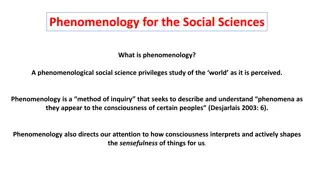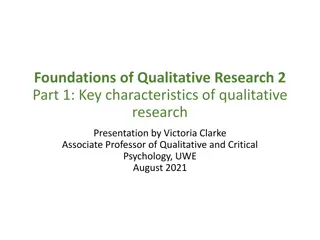Understanding Phenomenology and Grounded Theory in Qualitative Research
Phenomenology and Grounded Theory are key methods in qualitative research, focusing on understanding lived experiences and developing deep insights into phenomena. Phenomenology delves into the essence of appearances, while Grounded Theory explores the grounded elements of research. Through these methods, researchers can formulate meaningful research questions, identify strengths and weaknesses of approaches, and gain valuable insights into human experiences.
Download Presentation

Please find below an Image/Link to download the presentation.
The content on the website is provided AS IS for your information and personal use only. It may not be sold, licensed, or shared on other websites without obtaining consent from the author. Download presentation by click this link. If you encounter any issues during the download, it is possible that the publisher has removed the file from their server.
E N D
Presentation Transcript
Phenomenology and Grounded Theory DR. Rania Albsoul 1
Intended Learning outcomes After this lecture, and with further reading, you will be able to: 1. Understand the meaning of phenomenological research. 2. Describe the key tenets of phenomenological research. 3. Formulate a research questions that suit phenomenological research. 4. Identify strengths and weaknesses of phenomenological approach qualitative research. 5. Understand the meaning of Grounded Theory (GT) research. 6. Describe the key element, uses and steps of GT research. 2
Phenomenology The lived Experience The term phenomenology comes from Greek Phainomenon (appearance, manifestation) and logos (the science of). Phenomenology refers to reasoned inquiry into the nature of appearances. Edmund Husserl (1859- 1938), the German Mathematician, is the founder of the phenomenological movement (the father of phenomenology). Moustakas is a major name in phenomenology today. Phenomenology as a method has four characteristics, namely Descriptive, Reduction, Essence and Intentionality (Umanailo, 2019). 3
Phenomenology The Lived Experience(continued) At the core of phenomenology lies the attempt to describe and understand phenomena as experienced by individuals who have lived through them (Please refer to the paper: Women's narratives during the acute phase of their myocardial infarction). Very simply The nature and meaning of human experience as it is lived, perceived and experienced 4
Phenomenology Question.How we can have a knowledge of the world? Edmund Husserl argued that in order to answer the question of how we can have a knowledge of the world : we ought to turn our attention to the study of our experience of it. Example: we need to increase our knowledge about (lived) experiences of new teachers with technology and the influence of these experiences on their teaching practice and on student learning. 5
What is phenomenology? (continued) Phenomenology concerns/ helps researchers to apprehend lived experience within a specific group (for example: experience of illness, such as clinically inflicted pain). The type of problem best suited for phenomenology is one in which it is important to understand several individuals' common or shared experiences of a phenomenon. Phenomenology is important to develop practices or policies, or to develop a deeper understanding of the phenomenon. Phenomenology is never quantitative. 6
Goal of phenomenology To describe the meaning of this experience both in terms of What was experienced? and How it was experienced?. By examining an experience as it is subjectively lived, new meanings and appreciations can be developed to inform, or even re-orient, how we understand that experience. 7
Phenomenology (Definition) According to Creswell (2007), a phenomenological study describes the meaning for several individuals of their lived experiences of a concept or a phenomenon. 8
Phenomenology (Philosophical underpinnings) Return to traditional task of philosophy - From scientism to a broader search for wisdom. Philosophy without presuppositions - Suspend (transcend) judgments or past knowledge about what is real, the natural attitude about a phenomena (i.e. Bracketing). Intentionality of Consciousness (mental representation) - The mind is directed toward objects of consciousness that can be reflected upon. - The directedness (Intentionality) of experience toward things (objects) in the world. Refusal of the subject-object dichotomy - There is no subject distinct from the external world of things (objects). - Reality of phenomena is only understood by the experience of the individual (constructivist). 9
The intentionality of consciousnessClarification Consciousness - Qualitative or Subjective or Representational character of mind or experience. Intentionality - The aboutness or directedness of mind (or states of mind) to things, objects, states of affairs, events. - What are you thinking of? and What are you thinking about? Example: When I see a tree, my perception is a perception of a tree. When I think that 3 + 2 = 5, I am thinking of or about certain numbers and a relation among them. 10
Phenomenological Questions What is this lived experience (of a group) around (specific phenomenon) like? What is it like to experience this phenomenon or event? What are the meanings, structures, and essence of the lived experience of ( a specific phenomenon) by (individuals experiencing the phenomenon). Examples: a. What is it like to be bored? b. What is it like to experience a heart transplant? c. What is it like to experience empathy? d. What is it like to experience pain? 11
Fields often use phenomenology Social sciences Health sciences Psychology Nursing Education Phenomenology is well-suited to studying research questions involving affective, emotional, and often intense human experience. 12
Phenomenology Types 1. Descriptive (Transcendental) phenomenology - Focus less on researchers interpretation and more on describing experiences of participants. 2. Interpretive (Hermeneutical) phenomenology - Reflecting on lived experiences with interpretation by the researcher. 13
Descriptive phenomenology The goal of the researcher is to achieve Transcendental Subjectivity. Transcendental subjectivity means that the impact of the researcher on the inquiry is constantly assessed and biases and preconceptions neutralized, so that they do not influence the object of study. The process is transcendental because the researcher sees the phenomenon newly, as for the first time. More simply: It is an attempt to approach a lived experience with a sense of newness to elicit rich and descriptive data. The researcher is to stand apart, and not allow his/her subjectivity to inform the descriptions offered by the participants. The concept of bracketing: Researchers setting aside their pre-understanding and acting non-judgementally (Epoche) 14
Bracketing A methodological device of phenomenological inquiry that requires deliberate putting aside one s own belief about the phenomenon under investigation or what one already knows about the subject prior to and throughout the phenomenological investigation to better examine the consciousness itself. - For instance, a study could be designed to have multiple researchers triangulate their reductions (researchers triangulation) to confirm appropriate bracketing was maintained. - Alternatively, a study could involve validation of data via member checking (participant validation) to ensure that the identified essences resonated with the participants experiences. 15
Example of Descriptive phenomenology paper Medical students understanding of empathy: a phenomenological study. https://onlinelibrary.wiley.com/doi/pdf/10.1111/j.1365- 2923.2011.04152.x 16
Interpretive phenomenology In interpretive phenomenological approach, it is acknowledged that pre-understanding cannot be eliminated or bracketed . Researchers can interpret a phenomenon only through their own experiences. The present can be understood only through the past, and the past can be understood only through the present. 17
Interpretive phenomenology (continued) The use of hermeneutic phenomenology enabled the exploration of participants experiences with further abstraction and interpretation by the researchers based on researchers theoretical and personal knowledge. 18
Example of interpretive phenomenology paper Emotional events. The nature, triggers, and effects of shame experiences in medical residents. 19
Design characteristics Purposive samples of 5-25 usually going for saturation. -The individuals must have experience the phenomenon. - The more diverse the people, the harder it is to find common experiences. Data collection is by interview of the groups or individual that are verbatim, taped, and field notes. Data collection is directly tied to analysis, that eventually is coded or structured into themes. 20
Phenomenology Process/Methods Determine phenomenology is best approach for research question/objective. Identify the phenomenon to study. Recognise the philosophical assumptions of phenomenology. Describe researcher s own experience with phenomenon. 21
Phenomenology Process/Methods (continued) Bracket (or epoche) researcher s assumptions regarding phenomenon. Collect data about experiences of phenomenon. Develop a composite description of experiences. - What and how experienced 22
Data collection Protocol writing - individuals write-up their own experiences. Interviewing - Gather narrative data from conversations. - Two broad questions are the focus of the interview What have you experienced in terms of this phenomenon? What contexts or situations have typically influenced or affected your experiences of the phenomenon? Observation - Gather data by observing. Studying literature, diaries, journals and so on 23
Data analysis Horizontalization - Laying out all the data to examine it as equals. Highlight significant statements that provide understanding of participants experiences. Organise the data into clusters and themes. Phenomenological Reduction - Process of continually returning to the essence of the experience to derive inner meaning. 24
Data analysis (continued) Textual descriptions of participants experiences. - Description of the context and how participants experienced the phenomenon. Description of the researcher s experiences. Write a composite description of the phenomenon. - The essence - Focus on common experiences of participants. 25
Reporting format Moustaka s structure for a phenomenological study s write-up: - Introduction and statement of topic and outline. - Review of relevant literature. - Conceptual framework of the model. - Methodology - Presentation of data - Summary, implications, and outcomes 26
The reader should come away from the phenomenology with the feeling, I understand batter what it is like for someone to experience that 27
Grounded Theory (Definition and background) Barney G. Glaser and Anselm L. Strauss, are the creators of Grounded Theory (GT) method in their book The Discovery of the Grounded Theory: Strategies for Qualitative Research in late 1960s. In their book, the term GT is used in a more sense to denote theoretical constructs derived from qualitative analysis of data. Grounded Theory is often used to describe research that does not start from some prior theoretical understanding of what is going on (process), but works inductively, or from the ground up to build a theory of what is going on (Dew, 2007). GT is a systematic (uses systematic set of procedures) qualitative research methodology in which the inquirer generates a general explanation (a theory) of a process, action, or interaction grounded in the views of participants in the study about a topic (Creswell & Poth, 2007). 28
Grounded Theory (Definition and background) (Continued) GT is a systematic set of techniques and procedures that enable researchers to identify concepts and build theory from qualitative data (Strauss & Corbin, 2008). GT is primarily inductive, which means that researchers move from the specific to the general to explain phenomena in the qualitative theory-generating process (Foley & Timonen, 2015). 29
Grounded Theory (Definition and background) (continued) A key idea is that this theory-development does not come "off the shelf," but rather is generated or "grounded" in data from participants who have experienced the process ( developed theories are grounded in the collected data ( see limitations: GT ignores or avoids literature review). Grounded theorists not only code data for concepts (e.g., older adults recognize the importance of preventative approaches to health, most commonly mentioned being the winter flu vaccine) but also identify relationships between concepts/categories (i.e., variables) to build substantive theory (e.g., social class features as the strongest explanation of the likelihood of seeking flu vaccination in the sample)(Foley & Timonen, 2015). 30
Grounded Theory (Definition and background) (continued) The hallmark of grounded theory studies consists of the researcher deriving his or her analytic categories directly from the data, not from preconceived concepts or hypotheses. - They do not force preconceived ideas and theories directly upon their data. Rather, they follow the leads that they define in the data. It is mainly used for qualitative research. But also applicable to other data. The method is particularly relevant for research on issues for which limited prior research has been conducted and for which theory building is needed 31
Grounded Theory (Definition and background) (continued) GT is a research method that operates almost in a reverse fashion from traditional research and at first may appear to be in contradiction to the scientific method. 32
Grounded Theory uses GT should be used when the researcher: 1. Wishes to set aside theoretical ideas and generate a theory rather than to use one off the shelf . 2. Wishes to use the constant comparison of instances of data. 3. Wishes to explain a process ( What is going on here ), action, or interaction. 4. When current theories about a phenomenon are either inadequate or non existent. . 33
Characteristics of Grounded Theory methods (Why GT is unique?) 1. Simultaneous involvement in data collection and analysis phases of research. - Researcher's emerging analysis shapes his or her data collection procedures. - Insights emerging from early data shape further data collection, which in turn adds to existing understanding, and so on until saturation occurs. - Example: using the data analysis of the first interviews to modify the interview format in order to explore certain concepts in more depth (Burck, 2005). - Please see the challenges of GT in later slides ( the problem of induction). 2. Creation of analytic codes and categories developed from data, not from preconceived hypotheses. 34
Characteristics of Grounded Theory (continued) 3. Memo-making, that is, writing analytic notes to explicate and fill out categories, the crucial intermediate step between coding data and writing first drafts of papers. - Memos are informal analytic notes about the data and the theoretical connections between categories (Glaser & Holton, 2004). 4. Theoretical sampling, that is, sampling is driven by concepts or categories (i.e., variables) that emerge during data analysis and the need for further elaboration of these categories to develop theory (Creswell & Poth, 2007). - Theoretical sampling means that starting by interviewing a small number (sometimes just one or two) people whose characteristics are relevant to the study, and selecting further participants on the basis of the information gathered from the early interviews (Foley & Timonen, 2015). - Example: in a study of maternity care services use among immigrants of African origin, starting with participants who fit this broad selection criteria before starting to purposively select some who are Muslim, others who are Christian, because early interviews suggested the importance of religion in inclination to access services). - Sampling ceases in GT studies when categories are well described and dimensionalized. This is known as saturation of the data. Saturation is not dependent on the amount of data that has been collected and analysed, but rather occurs when no significant new insights are emerging (i.e., additional interviews are not generating novel data/data necessary for fleshing out the categories that have already emerged) (Foley & Timonen, 2015). 35
Characteristics of Grounded Theory (continued) 5. Employment of Constant Comparative Method (CCM), in which theory emerges while constantly comparing data from different categories (Creswell & Poth, 2007). - If a label appears repeatedly then the researcher can be satisfied with its existence. - Combines systematic data collection, coding, and analysis with theoretical sampling in order to generate theory that is integrated and expressed in a form clear enough for further testing (Conrad, 1993). 36
Characteristics of Grounded Theory (continued) 6. Delay of the literature review - GT supports initial data collection and preliminary analyses before attempting to incorporate previous research literature. - Pre-existing knowledge about the topic is deliberately withheld until initial data collection and analysis are complete, in order to prevent it from influencing the research findings. - As such, GT focuses on Emergence, that is, a research should start from a position where the researcher knows nothing about what they are studying, so that all concepts truly emerge from the data (Hancock, Ockleford, & Windridge, 2009). 37
Stages of Grounded theory research (Four stages) 1. Rather than beginning by researching and developing a hypotheses, the first step is data collection, through a variety of methods ( this contrasts with the scientific methods that how you generate a theory). - Rather than data collection being a process of testing a pre-existing hypothesis (scientific methods). - Qualitative interviews with individual participants are the most commonly used methods for data collection in GT research. - Data collection in GT can also incorporate observational methods at one point, over time and in similar/different contexts. - Careful compilation of field notes is important in GT research. Field notes in GT studies might contain some early analytical note taking, but they essentially describe the interview setting and record observations (Foley & Timonen, 2015). 2. From the data collected, the key points are marked with a series of codes, which are extracted from the text. - Coding is the process of naming or labelling things, categories and properties. 3. The codes are grouped into similar concepts in order to make them more workable. 4. From these concepts, categories (themes) are formed, which are the basis for the creation of theory. 38
Challenges Truly inductive analysis is not possible and is always limited by the unconscious application of prior knowledge to the thematic analysis process- either from the researcher s own experience or from their reading of the literature 39
Challenges (continued) The researcher faces the difficulty of determining when categories are saturated or when the theory is sufficiently detailed. - The use of discriminant sampling. - Researchers gathered additional information from individuals similar to those people initially interviewed to determine if the theory holds true for these additional participants. 40
Challenges (continued) Studies are often limited by the available time or funding, and where smaller numbers of interviews are analysed there is a danger that the results may be incomplete and that the effect of bias may be greater. 41
Samples for Grounded Theory paper Nurse patient collaboration: A grounded theory study of patients with chronic obstructive pulmonary disease on non-invasive ventilation. A Grounded theory study of the intention of nurses to leave the profession. 42
References Burck, C. (2005). Comparing qualitative research methodologies for systemic research: The use of grounded theory, discourse analysis and narrative analysis. Journal of family therapy, 27(3), 237-262. Chapman, A., Hadfield, M., & Chapman, C. (2015). Qualitative research in healthcare: an introduction to grounded theory using thematic analysis. Journal of the Royal College of Physicians of Edinburgh, 45(3), 201-205. Conrad, C. (1993). Qualitative research in higher education: Experiencing alternative perspectives and approaches: Ginn Press. Creswell, J. W., & Poth, C. N. (2007). Qualitative inquiry and research design: Choosing among five approaches: Sage publications. Dew, K. (2007). A health researcher's guide to qualitative methodologies. Australian and New Zealand journal of public health, 31(5), 433-437. Foley, G., & Timonen, V. (2015). Using grounded theory method to capture and analyze health care experiences. Health services research, 50(4), 1195-1210. Glaser, B. G., & Holton, J. (2004). Remodeling grounded theory. Paper presented at the Forum Qualitative Sozialforschung/Forum: Qualitative Social Research. Hancock, B., Ockleford, E., & Windridge, K. (2009). An introduction to qualitative research: Trent focus group. Strauss, A., & Corbin, J. (2008). Basics of qualitative research techniques: Sage publications Thousand Oaks, CA. Umanailo, M. C. B. (2019). Overview Phenomenological Research. 43
Thank you ! Questions Comments 44























